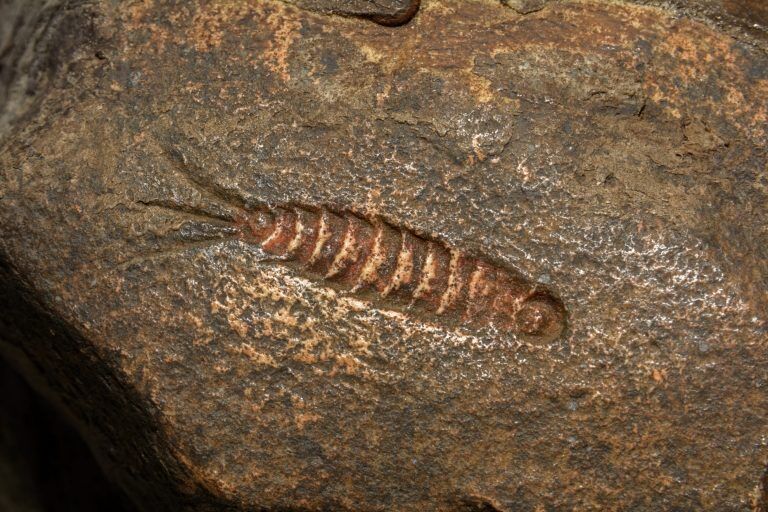Insects

Fossil trilobite imprint in the sediment
Table of Contents
To learn more about arthropods, look at the previous tutorial.
The Class Insecta of the Arthropoda Phylum is by far the most successful and diverse taxon on planet Earth. In fact, there are more species of insects than any other species combined. This surely illustrates that insects have particular selective advantages that allow them to take the most advantage of the environment that they live in.
The development of insects was a stamping of authority by animal species on life developing at the time.
Insects possess all the selective advantages of the arthropods mentioned on the previous tutorial page plus their own unique advantages with each species of them. Here are some reasons as to why insects enjoyed their continued existence over such a long period of time (beginning over 400 million years ago).
An Ability to Fly (Class Pterygota)
Since some insects developed wings they could easily escape from predators and travel large distances without any danger in the form of other animals in the air. Most likely the first insects were wingless. This suggests that flying was a natural selective advantage at the time and has continued to be for many insect species.
Small Stature
Insects would develop respiratory complications if they grew to an abnormal size. In light of this, the wide range of insect species is small in size, meaning they can occupy small areas and require a small amount of food in order for them to survive.
Fast Reproductive Cycle
A general rule of thumb in biology is that smaller organisms produce offspring faster, and as organisms of the time reproduced sexually, this meant that the crossing of genetic information was more frequent. This, in turn, meant that variation in the genome of the species increased as a whole, and thus continued to diversify and compete.
Land Insects
Just like the other arthropods, they took the opportunity to occupy dry land, and thus evolved to cater to their new environment. Evolutionary adaptations mapped out in insect species points out the minimum water transpired by the organisms, illustrating their relatively audacious transition from a wet environment to dry land.
Insects also occupy the sea. However, they faced stiffer competition from the continuous evolution that was happening there with other species. This created environmental pressure and an occupational threshold of habitats.
Senses
Insects continued to evolve the sense developed by other arthropods and their ancestors. They were capable of interpreting auditory, visual, and chemical stimuli.
The Symbiosis of Plants and Insects
Over the evolutionary timeline we have followed, although plants have not been mentioned much, insects were heavily dependent on plant life. Both insects and plants have co-evolved with one another. If you had removed one of them at any point in history scores of species would have never existed in today’s world.
Insect and Plant Interactions
Butterflies undergo a process called metamorphosis, which is a transition from embryonic to the adult form of a species. In the case of the butterfly, adults hatch eggs within plants to camouflage them against potential damage and predators who may eat the eggs.
In other cases, insects are herbivores. This means they eat plants as a means of nutrition. In reverse instances, plants like the Venus Fly Trap engulf insects within their defensive mechanisms and kill them.
Insects pollinate plants, providing a way for plants to create offspring and successfully pass their genome through the generations.
Plants and insects have always had a close relationship with evolution.
Social Habits
Some species of insects are capable of communicating with one another. This would be one of the first instances of this in the evolutionary chain and remarkably happening hundreds of millions of years ago. Bees are an example of a social insect that performs a waggle dance in front of fellow bees from the same hive to indicate the quality and navigational source of the food supply.
Indeed, insects were an important factor in life’s transition from water to land.
You will also like...
Animal Water Regulation
Animals adapt to their environment in aspects of anatomy, physiology, and behavior. This tutorial will help you understa..
Plant Water Regulation
Plants need to regulate water in order to stay upright and structurally stable. Find out the different evolutionary adap..
The Water Cycle
The water cycle (also referred to as the hydrological cycle) is a system of continuous transfer of water from the air, s..
Adaptation Tutorial
Adaptation, in biology and ecology, refers to the process or trait through which organisms or the populations in a habit..
Plant Biology
Plantlife can be studied at a variety of levels, from the molecular, genetic and biochemical level through organelles, c..
The Origins of Life
This tutorial digs into the past to investigate the origins of life. The section is split into geological periods in the..